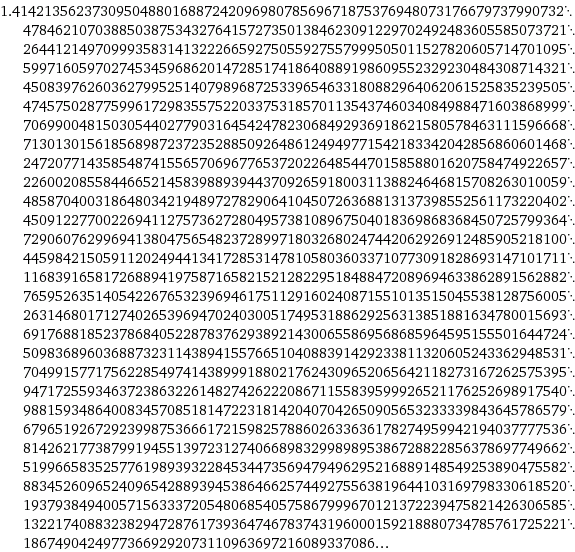How to Teach Square Roots
Conceptually
If you have taught for
any length of time, you’ll surely have seen one of these two things below.
24−−√=62–√ or 4–√=2–√
Sure, this can be
corrected procedurally. But, over time,
they’ll forget the procedure and revert back to following whatever
misconception they possess that has them make these mistakes in the first
place.
I’d like to share with
you a few approaches that can help.
Keep in mind, there is no way to have students seamlessly integrate new
information with their existing body of knowledge. There will always be confusion and misunderstanding. By focusing in on the very nature of the
issues here, and that is lack of conceptual understanding and lack of
mathematical literacy, we can make things smoother, quicker, and improve
retention.
Step one
is to teach students to properly read square roots. Sure, a square root can be an operation, but
it is also the best way to write a lot of irrational numbers. Make sure you students understand these two
ways of reading a square root number.
1. 2–√ asks, "What squared is 2?"2. If you square the number, 2–√, the product is 2.
Students are quick
studies when it comes to getting out of responsibility and side-stepping
expectations. Very quickly, when asked
“What does the square root of 11 ask?” students will say, “What squared is the
radicand?”
When pressed on the
radicand, they may or may not understand it is 11. But, they’ll be unlikely to have really
considered the question for what it asks.
Do not be satisfied with students that are just repeating what they’ve
heard. Make them demonstrate what they
know. A good way to do so is by asking a
question like the one below.
How is 9–√ like x2=9.
Another way to test their
knowledge is to ask them to evaluate the following:
2–√×2–√.
We do not want students
saying it is the square root of four at this point. To do so means they have not made sense of
the second fact listed about the number.
An alternative to using a Natural Number as the radicand is to use an
unknown. For example:
m−−√×m−−√.
Step two
requires them to understand why the square root of nine, for example, is
three. The reason why it is true has
nothing to do with steps. Instead, the
square root of nine asks, “What squared is 9?”
The answer is three. There is no
other reason.
Once again, students make
excellent pull-toy dolls, saying random things when prompted. Once in a while they recite the correct
phrase, even though they don’t understand it, and we get fooled. It is imperative to be creative and access
their knowledge in a new way.
Before I show you how
that can be done with something like the square root of a square number, let’s
consider the objections of students here.
Students will complain that we’re
making it complicated, or that we are
confusing them.
First, we’re not making
the math complicated. Anything being
learned for the first time is complicated.
Things only become simple with the development of expertise. How complicated is it to teach a small child
to tie their shoes? But once the skill
is mastered, it is done without thought.
The second point is that
we are not confusing them, they are already confused. They just don’t know it yet. They will not move from being ignorant to
knowledgeable without first working through the confusion. If we want them to understand so they can
develop related, more advanced skills, and we want them to retain what they’re
learning, they have to understand. They
must grasp the concept.
So how can we really
determine if they know why the square root of twenty-five is really five? We do so by asking the same question in a new
way.
Given that the number k2=m, what is m−−√?
Another way to get at the
knowledge is by asking why the square root of 25 is not 6. Students will say, “Because it’s five.” While they’re right, that does not explain
why the square root of 25 is not six.
Only when they demonstrate that 62 = 36, not 25, will they
have shown their correct thinking. But,
as is the case with the other questions, students will soon learn to mimic this
response while not possessing the knowledge.
So, you have to be clever and on your toes. This point is worth laboring!
Step three
involves verifying square root simplification of non-perfect squares. This uncovers a slew of misconceptions, which
will address. Before we get into that, here is exactly what I mean.
Is this true: 24−−√=26–√ ?
Have students explain
what is true about the square root of twenty-four. There are two ways they should be able to
think of this number (and one of them is not as an operation, yet).
1. What squared is 24?
2. This number squared is 24.
The statement is true if
“two times the square root of six, squared, is twenty-four.” Just like the square root of 9 is three only
because 32 = 9.
The first hurdle here is
that students do not really understand irrational numbers like the square root
of six. They’ve learned how to
approximate and do calculation with the approximations. Here is how they see
it.
2–√=1.4
3+2–√=4.4
3×2–√=4.2
What this means is that students believe:
1. Addition of a rational number and an irrational number
is rational.
2. The product of a rational and irrational number is
also rational.
a.
This can be true
if the rational number is zero.
This
misunderstanding, which naturally occurs as a byproduct of learning to
approximate without understanding what approximation means, is a major hurdle
for students. It must be addressed at
this time.
To do so, students need
to be made to understand that irrational numbers cannot be written with our
decimal or fraction system. We use
special symbols in the place of the number itself, because we quite literally
have no other way to write the number.
A good place to start is
with π. This number is the ratio of a
circle’s diameter and its circumference.
The number cannot be written as a decimal. It is not 3.14, 22/7, or anything we can
write with a decimal or as a fraction.
The square root of two is similar.
The picture below shows probably over 1,000 decimal places, but it is
not complete. This is only close, but
not it.

Students will know the
Pythagorean Theorem. It is a good idea
to show them how an isosceles right triangle, with side lengths of one, will
have a hypotenuse of the square root of two.
So while we cannot write the number, we can draw it!
The other piece of new
information here is how square roots can be irrational. If the radicand is not a perfect square, the
number is irrational. At this point, we
cannot pursue this too far because we’ll lose sight of our goal, which is to
get them to understand irrational and rational arithmetic.
This point, and all
others, will be novel concepts. You will
need to circle back and revisit each of them periodically. Students only will latch on to correct
understanding when they fully realize that their previously held believes are
incorrect. What typically happens is
they pervert new information to fit what they already believed, creating new
misconceptions. So be patient,
light-hearted and consistent.
Once students see that
the square root of two is irrational, they can see how they cannot carry out and
write with our number system, either of these two arithmetic operations:
3+2–√ or 3×2–√.
This will likely be the
first time they will understand one of the standards for the Number Unit in
High School level mathematics.
Students must demonstrate that the
product of a non-zero rational and irrational number is irrational.
Students must demonstrate the sum of
a rational and an irrational number is irrational.
Keep in mind, this may
seem like a huge investment of time at this point, and they don’t even know how
to simplify a square root number yet.
However, we have uncovered many misconceptions and taught them what the
math really means! This will pay off as
we move forward. It will also help
establish an expectation and introduce a new way to learn. Math, eventually, will not be thought of as
steps, but instead consequences of ideas and facts.
Back to our question:
Is this true: 24−−√=26–√ ?
Just like the square root
of nine being three because 32 = 9, this is true if:
(26–√)2=24.
Make sure students
understand that there is an unwritten operation at play between the two and the
irrational number. We don’t write the
multiplication, which is confusing because 26 is just considered differently. It isn’t 12 at all (2 times 6)!
Once that is established,
because of the commutative property of multiplication,
26–√×26–√=2×2×6–√×6–√.
There should be no talk
of cancelling. The property of the
square root of six is that if you square it, you get six. That’s the first thing they learned about
square root numbers.
2×2×6–√×6–√=4×6.
As mentioned before,
students are quick studies. They learn
to mimic and get right answers without developing understanding. This may seem
like a superficial and easy task, but do not allow them to trick themselves or
you regarding their understanding.
A good type of question
to ask is:
Show that mnm−−√=m3n2−−−−−√.
To do this, we students
to square the expression on the left of the equal sign to verify it equals the
radicand. This addresses the very
meaning of square root numbers.
Last step
is to teach them what the word simplify means in the context of
square roots. It means to rewrite the
number so that the radicand does not contain a perfect square.
The way to coach students
to do this is to factor the radicand to find the largest square number. This is aligned with the meaning of square
roots because square roots ask about square numbers. When they find the LARGEST perfect square
that is a factor of the radicand, the rewrite the expression as a product and
then simply answer the question asked by
the square roots. Here’s what it
looks like.
Simplify 48−−√.
48=2×24, 3×16, 4×12, 6×8.
48−−√=16−−√×3–√
Write the square root of the perfect square first so that you do not end up
with 3–√4, which looks
like 34−−√.
48−−√=4×3–√.
At this point, students
should be ready to simplify square roots.
However, be warned about a common misconception developed at this
point. They’ll easily run the two
procedures into one. They often write
things like:
Simplify 18−−√.
18−−√=9–√×2–√
18−−√=32–√
(32–√)2=9×2
9×2=18
18−−√=18.
The moral of the story
here is that to teach students conceptually means that you must be devoted,
diligent and consistent with reverting back to the foundational facts, #1 and
#2 at the beginning of this discussion.
This approach in no way
promises to prevent silly mistakes or misconceptions. But what it does do is create a common
understanding that can be used to easily explain why 12−−√ is not 32–√. It is not
“three root two,” because (32–√)2=18, not 12.
This referring to the
conceptual facts and understanding is powerful for students. Over time they
will start referring to what they know to be true for validation instead of
examination of steps. There is not a
step in getting 12−−√=32–√, that is
wrong. What is wrong is that their work
is not mathematically consistent and their answer does not answer the question,
what squared is twelve?
If a student really
understands square roots, how to multiply them with other roots, and how
arithmetic works irrational and rational numbers, the topics that follow go
much more quickly. After this will be
square root arithmetic, like 52–√−38–√, and then cube
roots and the like. Each topic that you
can use to dig deep into the mathematical meaning will, over time, quicken the
pace of the class.
In summary:
1.
Square roots have
a meaning. The meaning can be considered
a question or a statement, and both need to be understood by students.
a.
This meaning is
why the square root of 16 is 4.
2.
Square roots of
non-square numbers are irrational.
Arithmetic with rational and irrational numbers is irrational (except
with zero).
3.
To simplify a
square root is to rewrite any factor of the radicand that is a perfect square.
a.
When rewriting,
place the square root of the square number first.
4.
The simplification
of a square root number is only right if that number squared is the radicand.
I hope you find this
informative, thought-provoking, and are encouraged to take up the challenge of
teaching conceptually! It is well worth
the initial struggles.
For lessons, assignments,
and further exploration with this topic, please visit: https://onteachingmath.com/squareroots/





